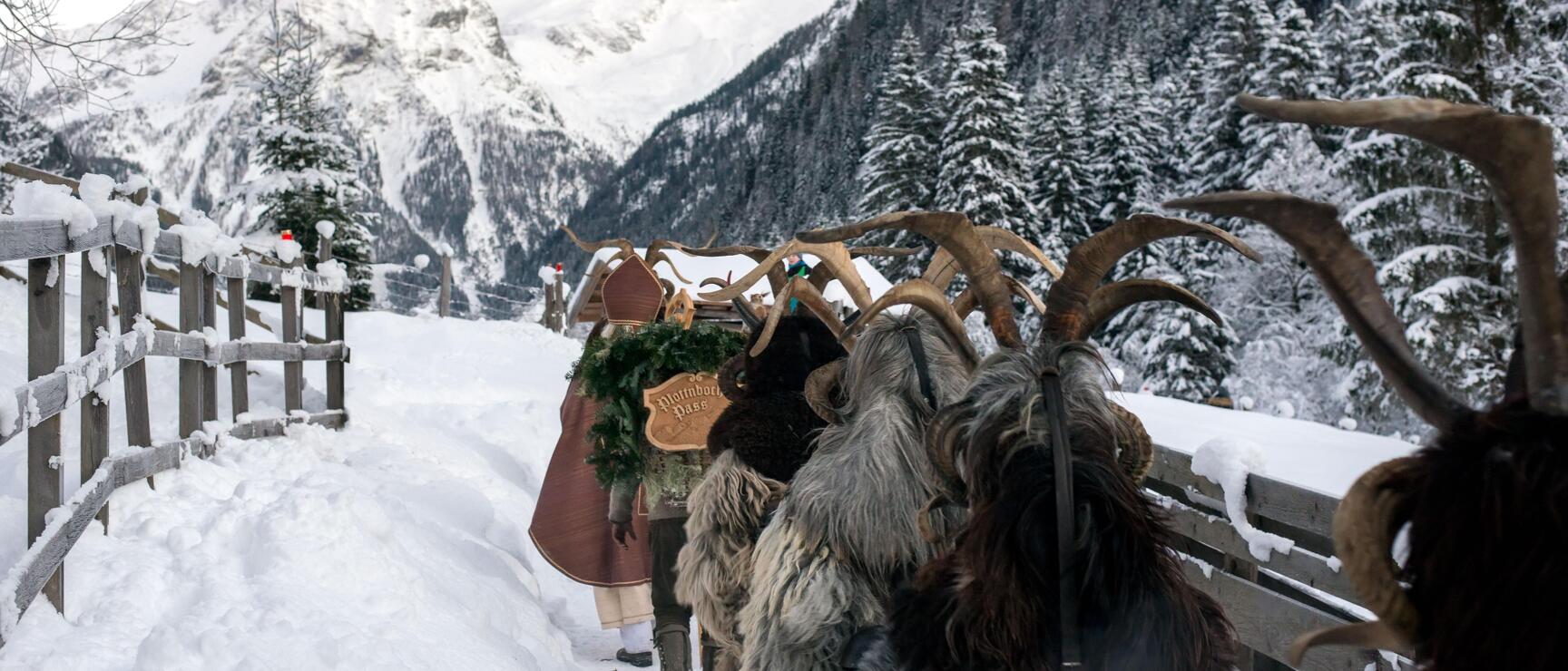
A Raucous Christmas: Winter Traditions in Austria
Wild Christmas
While St. Nicholas clearly has Christian origins, tracing back to Saint Nicholas of Myra, the origins of Krampus remain largely mysterious. Some believe that even the Celts tried to ward off the approaching winter with masks, horns, and fur, similar to the Perchten, who were meant to drive winter away. The Greeks also had horned, goat-legged creatures, such as the satyrs in the Dionysian cult. Horst Wierer, an archivist and expert on traditions from Bad Hofgastein, points to one of the earliest written references to Krampus by Saint Augustine around 400 AD. He wrote about young people dressed in furs, roaring through the streets during the Epiphany period, a practice Augustine deemed unchristian and sought to eradicate.
The Krampus tradition remains alive in many rural areas of Austria. Celebrations begin on 5 December, the eve of St. Nicholas Day. One of the most authentic Krampus runs take place in the Gastein Valley, where around 100 groups, or Passen, participate. Each Krampus wears an elaborately carved mask made from Swiss stone pine, with horns and furs sourced from local goats and rams. As elsewhere, the shaggy figure accompanies St. Nicholas, but in the Gastein Valley, the Krampus is not an embodiment of evil; instead, it banishes it. During the traditional “Rempeln,” these rugged figures wrestle each other using only their shoulders, symbolising the triumph over evil.
Magical raucous nights
The most important raucous traditions
Mystical Austria
Krampus, St. Nicholas and the "nice children"
Around Christmas, people not only celebrate the birth of Christ but also indulge in many pagan customs. This can sometimes be quite frightening.
When Christoph Waltz spoke about Krampus on the Jimmy Fallon Show in 2014, the US audience could no longer contain their excitement. In disbelief, people across the pond heard that during the peaceful Advent season in Austria, a masked devil figure dressed in furs goes around threatening children with a rod.
Well, it's not quite that bad. After all, the Krampus is the companion of the ever-popular St. Nicholas, who presents well-behaved children with sweets and nuts on 6 December.
Krampus runs in Austria
An eerie turn of the year
The customs of the Rauhnächte (raucous nights)
The raucous nights, or "smoke nights," are steeped in mystery. These nights fall between Christmas and 6 January, with their number varying by region, ranging from three to twelve. In some areas, the traditions begin as early as "Thomas" night, the longest night of the year, from 20 to 21 December, with the practice of Losen.
Derived from the dialect word for "listening," Losen is a custom where people try to gain insight into the future by paying close attention to sounds. Some gather at remote crossroads to listen intently. Interpreting these sounds is no easy task, but their meanings are believed to be profound: For example, hearing joyful singing is said to foretell a wedding, while the sound of a saw is thought to signify an impending death.
Who is afraid of the "Wild Hunt"?
The Rauhnächte were long seen as ominous, marked by the "Wild Hunt," a spectral horde said to bring misfortune. Even today, Austrians avoid hanging laundry during this time, fearing it might snare the Wild Hunt.
Similarly feared is the “Habergoaß,” a goat-like demon from Salzburg's Perchten processions, believed to carry children away in its basket.
Branches that bring luck
The Christmas season also brings charming pagan traditions. Mistletoe, once a Germanic symbol of good fortune, is now hung in doorways, where couples kiss to welcome a happy future.
Another custom is the Barbarazweige: fruit tree branches cut on St. Barbara’s Day (4 December). If they bloom by Christmas Eve, they’re seen as a sign of good luck for the year ahead.
A fragrant winter tradition
Smudging to ward off the "Wild Hunt"
The Rauhnächte likely derive their name from Rauch (smoke), with smudging still a widely practised winter custom, especially in rural areas. On at least one night between Christmas and Epiphany, homes and stables are smudged with frankincense to protect animals from negative influences.
Folklore says animals gain the ability to speak at midnight during these nights, but listening is said to bring doom. To ward off misfortune, people also swallow Schluckbildchen—small papers bearing images of the Virgin Mary.
For a deeper dive into Rauhnächte myths, Hall in Tirol offers enchanting guided tours that reveal the origins of this fascinating tradition amidst the town's atmospheric alleys.
Socio-cultural sustainability
Why are traditions and customs sustainable?
The preservation of customs and traditions in Austria is closely linked to sustainability. Practices such as Alpine cattle drives, traditional festivals, and regional crafts reflect a deep respect for nature and its resources. These customs foster understanding and appreciation for local flora and fauna while also promoting environmental awareness.
Traditions also strengthen social sustainability. Celebrations like maypole raising, Easter festivities, or Christmas customs bring communities together, encouraging collective efforts to care for their region. Intangible cultural heritage honours rituals, traditions, and craftsmanship passed down through generations. Visitors who experience these customs firsthand immerse themselves in Austrian culture, which in turn helps reinforce local identity.